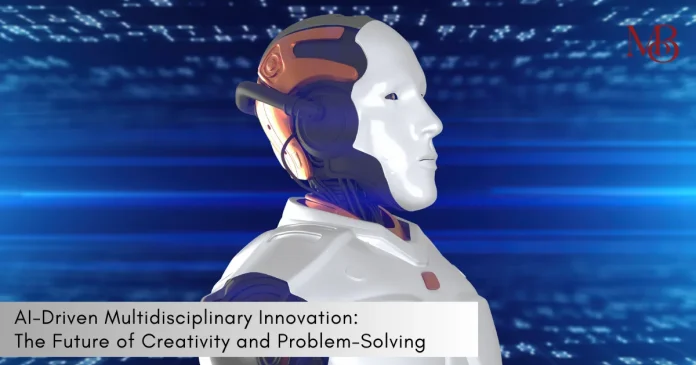In today’s fast-paced world, artificial intelligence (AI) is no longer confined to tech giants or sci-fi movies. It’s everywhere! From the apps on your smartphone to advanced scientific research, AI is driving innovation across multiple disciplines. And guess what? The magic truly happens when these disciplines collide.
This blog post will take you into how AI is driving innovation across multiple disciplines, exploring its significance and transformative impact on various industries. Let’s get started!
What Is AI-Driven Multidisciplinary Innovation?
Multidisciplinary innovation is all about bringing together different fields to solve problems or create something new. Imagine combining medicine with engineering, or art with technology. Now, add AI to the mix. It’s like adding a turbocharger to your creative engine.
Think of AI as the ultimate team player. It can analyze vast amounts of data, identify patterns, and even predict outcomes—making it easier for experts from various domains to collaborate effectively.
Why Is AI Perfect for Multidisciplinary Work?
Artificial intelligence or AI-Driven Multidisciplinary Innovation fosters by enabling the seamless integration and analysis of diverse data sources. This facilitates breakthroughs that would be otherwise unattainable within the confines of individual disciplines.
1. Data Integration: AI can process and integrate data from different sources and formats. For example, in healthcare, AI can combine genetic data with lifestyle information to create personalized treatment plans.
2. Breaking Down Silos: Often, different fields operate in silos, making collaboration tough. AI bridges these gaps by creating common platforms for sharing insights.
3. Speed and Efficiency: AI can crunch numbers and analyze trends faster than any human, freeing up time for creative problem-solving.
4. Uncovering Hidden Insights: AI often spots patterns and connections that humans might miss. This can lead to groundbreaking discoveries.

Examples of AI-Driven Multidisciplinary Innovation
Let’s explore some real-world examples to illustrate how AI is making a significant impact across various fields. These examples will showcase the diverse applications and transformative power of AI in different industries.
1. Healthcare and AI: AI-powered tools like IBM Watson Health analyze medical records, research papers, and clinical data to help doctors diagnose and treat diseases. When combined with engineering, these insights lead to innovative medical devices like AI-enabled prosthetics.
2. Art and Technology: Ever heard of AI-generated art? Platforms like DeepArt use AI algorithms to create stunning visuals by blending styles from famous artists. This fusion of art and technology is inspiring new forms of expression.
3. Environment and AI: AI helps environmental scientists track climate change, predict natural disasters, and develop sustainable solutions. When paired with urban planning, it leads to smarter, greener cities.
4. Education and AI: AI-driven platforms like Duolingo and Coursera personalize learning experiences. When integrated with psychology, they make education more engaging and effective.
How Businesses Are Adopting AI-Driven Multidisciplinary Approaches
Businesses are recognizing that multidisciplinary innovation is essential for maintaining a competitive edge. This approach fosters collaboration across different fields and expertise, leading to the development of novel solutions and groundbreaking ideas.
| Industry | AI-Driven Innovation |
| Retail | AI predicts trends by analyzing customer data and social media. |
| Finance | Combines AI with behavioral economics to prevent fraud. |
| Agriculture | Uses AI and robotics for precision farming. |
| Entertainment | AI-generated scripts and personalized content recommendations. |
AI-Driven Multidisciplinary Innovation in companies like Tesla, Amazon, and Google are leading the charge by fostering multidisciplinary teams powered by AI. It’s not just about technology; it’s about blending technology with human creativity and expertise.
How Can You Be Part of This Revolution?
You don’t need to be a tech wizard to join the AI-driven multidisciplinary movement. Here are some simple steps:
1. Learn the Basics of AI: Take free online courses on platforms like Coursera or Khan Academy. Understanding AI basics will help you see its potential in your field.
2. Collaborate Across Fields: Step out of your comfort zone. Network with people from other disciplines and exchange ideas.
3. Experiment with Tools: Try out AI tools relevant to your work. For example, Canva’s AI features can enhance graphic design projects.
4. Stay Curious: Read, explore, and experiment. The more you know, the more innovative you can be.
Challenges of AI-Driven Multidisciplinary Innovation
The potential of this technology is thrilling, but it’s important to be mindful of the obstacles that lie ahead. We must proceed with caution and carefully consider the potential downsides, while remaining optimistic about the possibilities.
- Data Privacy: Sharing data across disciplines can raise privacy concerns.
- Skill Gaps: Not everyone has the skills to work with AI.
- Bias in AI: AI systems can sometimes reflect biases in their training data.
- Cost: High-end AI tools and systems can be expensive.
The good news? These challenges are being tackled through better regulations, education, and advancements in technology.
How Kindness is Fueling a Silent Health Crisis in India by Feeding Pigeons
The Future of AI-Driven Multidisciplinary Innovation
The future is bright! As AI continues to evolve, we can expect:
- Smarter cities with AI-driven infrastructure.
- Breakthroughs in personalized medicine.
- New art forms and cultural experiences.
- Global solutions for climate change.
Facing Population Collapse: How Falling Fertility Rates are Shaping the Future
The emergence of AI has sparked concerns about job displacement, but the reality is quite different. AI isn’t designed to replace human workers, but rather to enhance their capabilities. By automating repetitive tasks and providing valuable insights, AI allows us to focus on higher-level activities that require creativity, critical thinking, and emotional intelligence. This collaborative approach unlocks new possibilities and enables us to achieve outcomes that wouldn’t be possible individually.
FAQs
1. What is AI-Driven Multidisciplinary Innovation?
It’s the combination of knowledge and expertise from multiple fields to solve problems or create something new.
2. How does AI help in multidisciplinary innovation?
AI processes data, identifies patterns, and bridges gaps between disciplines, making collaboration more effective.
3. Can AI replace human creativity?
No. AI enhances human creativity by providing tools and insights, but the spark of innovation comes from humans.
4. How can I learn AI skills?
Start with free resources like YouTube tutorials or online courses on Coursera, Udemy, or Khan Academy.
AI-driven multidisciplinary innovation is transforming the world, one idea at a time. The possibilities are endless, and the best part? We’re all part of this exciting journey. So, let’s embrace AI and get creative. Follow our Newscast page for more such articles.


